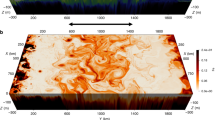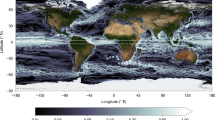Abstract
In steady state, the export of photosynthetically fixed organic matter to the deep ocean has to be balanced by an upward flux of nutrients into the euphotic zone1. Indirect geochemical estimates2 of the nutrient supply to surface waters have been substantially higher than direct biological and physical measurements3, particularly in subtropical regions. A possible explanation for the apparent discrepancy is that the sampling strategy of the direct measurements has under-represented episodic nutrient injections forced by mesoscale eddy dynamics, whereas geochemical tracer budgets integrate fluxes over longer time and space scales. Here we investigate the eddy-induced nutrient supply by combining two methods potentially capable of delivering synoptic descriptions of the ocean's state on a basin scale. Remotely sensed sea-surface height data from the simultaneous TOPEX/Poseidon and ERS-1 satellite missions are assimilated into a numerical eddy-resolving coupled ecosystem–circulation model of the North Atlantic Ocean. Our results indicate that mesoscale eddy activity accounts for about one-third of the total flux of nitrate into the euphotic zone (taken to represent new production) in the subtropics and at mid-latitudes. This contribution is not sufficient to maintain the observed primary production in parts of the subtropical gyre, where alternative routes of nitrogen supply will have to be considered.
This is a preview of subscription content, access via your institution
Access options
Subscribe to this journal
Receive 51 print issues and online access
$199.00 per year
only $3.90 per issue
Buy this article
- Purchase on Springer Link
- Instant access to full article PDF
Prices may be subject to local taxes which are calculated during checkout


Similar content being viewed by others
References
Eppley, R. W. & Peterson, B. J. Particulate organic matter flux and planktonic new production in the deep ocean. Nature 282, 677–680 (1979).
Jenkins, W. J. Nitrate flux into the euphotic zone near Bermuda. Nature 331, 521–523 (1988).
Lewis, M. R., Harrison, W. G., Oakey, N. S., Herbert, D. & Platt, T. Vertical nitrate fluxes in the oligotrophic ocean. Science 234, 870–873 (1986).
Dugdale, R. C. & Goering, J. J. Uptake of new and regenerated forms of nitrogen in marine production. Limnol. Oceanogr. 12, 196–206 (1967).
Falkowski, P. G., Ziemann, D., Kolber, Z. & Bienfang, P. K. Role of eddy pumping in enhancing primary production in the ocean. Nature 352, 55–58 (1991).
McGillicuddy, D. J. J & Robinson, A. R. Eddy-induced nutrient supply and new production in the Sargasso Sea. Deep–Sea Res. I 44, 1427–1450 (1997).
Dadou, I., Garçon, V., Andersen, V., Flierl, G. R. & Davis, C. S. Impact of the North Equatorial Current meandering on a pelagic ecosystem: A modeling approach. J. Mar. Res. 54, 311–342 (1996).
Williams, R. G. & Follows, M. J. The Ekman transfer of nutrients and maintenance of new production over the North Atlantic. Deep-Sea Res. I. 45, 461–489 (1998).
Oschlies, A. & Garçon, V. An eddy-resolving coupled physical-biological model of the North Atlantic. Part I: Sensitivity to advection numerics and mixed layer physics. Glob. Biogeochem. Cycles(submitted).
Bryan, F. O. & Holland, W. R. in Parameterization of Small-Scale Processes(eds Müller, P. & Henderson, D.) 99–115 (Proc. 'Aha Huliko'a, Hawaiian Winter Workshop, Spec. Publ., Hawaii Inst. Geophys, Manoa, (1989)).
Döscher, R., Böning, C. W. & Herrmann, P. Response of circulation and heat transport in the North Atlantic to changes in thermohaline forcing in northern latitudes: a model study. J. Phys. Oceanogr. 24, 2306–2320 (1994).
Blanke, B. & Delecluse, P. Variability of the tropical Atlantic Ocean simulated by a general circulation model with two different mixed-layer physics. J. Phys. Oceanogr. 23, 1363–1388 (1993).
Paulson, C. A. & Simpson, J. J. Irradiance measurements in the upper ocean. J. Phys. Oceanogr. 7, 952–956 (1977).
Levitus, S., Conkright, M. E., Reid, J. L., Najjar, R. G. & Mantyla, A. Distribution of nitrate, phosphate and silicate in the world oceans. Prog. Oceanogr. 31, 245–273 (1993).
Lafore, J.-P. et al. The Meso-NH atmospheric simulation system. Part I: Adiabatic formulation and control simulations. Ann. Geophysicae 16, 90–109 (1998).
Stammer, D. & Böning, C. W. Mesoscale variability in the Atlantic Ocean from GEOSAT Altimetry and WOCE high resolution numerical modeling. J. Phys. Oceanogr. 22, 732–752 (1992).
Le Traon, P. Y., Gaspar, P., Bouyssel, F. & Makhmara, H. Using TOPEX/POSEIDON data to enhance ERS-1 data. J. Atmos. Ocean. Technol. 12, 161–170 (1995).
Oschlies, A. & Willebrand, J. Assimilation of Geosat altimeter data into an eddy-resolving primitive equation model of the North Atlantic Ocean. J. Geophys. Res. 101(C6), 14175–14190 (1996).
Sarmiento, J. L. et al. Aseasonal three-dimensional ecosystem model of nitrogen cycling in the North Atlantic euphotic zone. Glob. Biogeochem. Cycles 7, 417–450 (1993).
Berger, W. H. in Productivity of the Ocean: Present and Past(eds Berger, W. H., Smetaceck, V. S. & Wefer, G.) 429–455 (Wiley, Chichester, (1989)).
Antoine, D., André, J.-M. & Morel, A. Oceanic primary production 2. Estimation at global scale from satellite (coastal zone color scanner) chlorophyll. Glob. Biogeochem. Cycles 10, 57–69 (1996).
Sathyendranath, S., Longhurst, A., Caverhill, C. M. & Platt, T. Regionally and seasonally differentiated primary production in the North Atlantic. Deep-Sea Res. I 42, 1773–1802 (1995).
Behrenfeld, M. J. & Falkowski, P. G. Photosynthetic rates derived from satellite-based chlorophyll concentration. Limnol. Oceanogr. 42, 1–20 (1997).
Platt, T. & Harrison, W. G. Biogenic fluxes of carbon and oxygen in the ocean. Nature 318, 55–58 (1985).
Archer, D., Pelzer, E. T. & Kirchman, D. L. Atimescale for dissolved organic carbon production in equatorial Pacific surface waters. Glob. Biogeochem. Cycles 11, 435–452 (1997).
Gruber, N. & Sarmiento, J. L. Global patterns of marine nitrogen fixation and denitrification. Glob. Biogeochem. Cycles 11, 235–266 (1997).
Sambrotto, R. N. et al. Elevated consumption of carbon relative to nitrogen in the surface ocean. Nature 363, 248–250 (1993).
Acknowledgements
We thank J. F. Minster for discussions, and W. Koeve and G. Evans for comments. This work was supported through the European Union ESCOBA program and the German JGOFS project funded by the BMBF.
Author information
Authors and Affiliations
Corresponding author
Rights and permissions
About this article
Cite this article
Oschlies, A., Garçon, V. Eddy-induced enhancement of primary production in a model of the North Atlantic Ocean. Nature 394, 266–269 (1998). https://doi.org/10.1038/28373
Received:
Accepted:
Issue Date:
DOI: https://doi.org/10.1038/28373
This article is cited by
-
A Lagrangian model for drifting ecosystems reveals heterogeneity-driven enhancement of marine plankton blooms
Nature Communications (2023)
-
Long-term evolution of ocean eddy activity in a warming world
Nature Climate Change (2022)
-
Influences of the Great Whirl on surface chlorophyll a concentration off the Somali Coast in 2017
Acta Oceanologica Sinica (2021)
-
Facing extremes: Cory’s shearwaters adjust their foraging behaviour differently in response to contrasting phases of North Atlantic Oscillation
Regional Environmental Change (2020)
-
The influence of geostrophic strain on oceanic ageostrophic motion and surface chlorophyll
Nature Communications (2019)
Comments
By submitting a comment you agree to abide by our Terms and Community Guidelines. If you find something abusive or that does not comply with our terms or guidelines please flag it as inappropriate.



